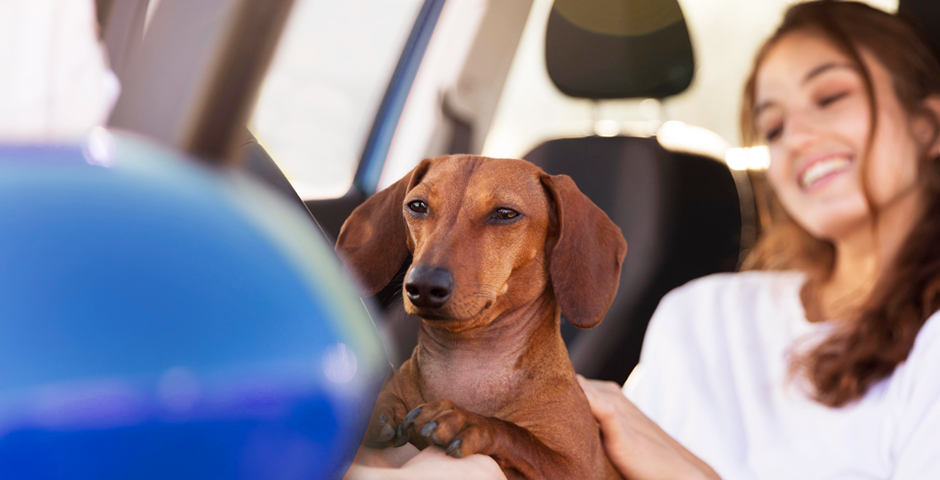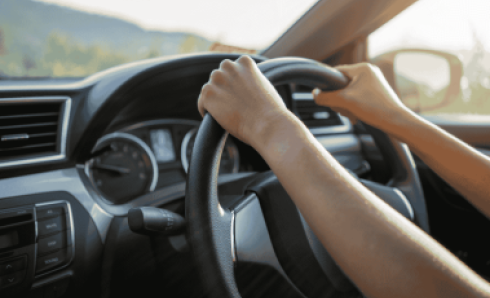1. PAWfect tips for travelling with your pet
Pet ownership has increased dramatically in Ireland since lockdown in early 2020 with many families seeing it as the perfect time to invest in a lifelong pet. But as everybody piles into the car, snacks for the trip are packed and last-minute toilet breaks are taken, the question of how your dog should be travelling often gets pushed way down the pecking order.
As much as we all love to see a dog living its best life - tongue lapping against its cheeks, hair billowing in the wind as it leans out of the car window - it is illegal to have a pet unsecured whilst a vehicle is moving.
It’s a fine line between safety and enjoying the thrill of the trip, but hopefully, we’ll be able to explain everything you need to know about travelling with dogs here.
2. Can I travel with a dog in the car?
There is no law against travelling with a dog in the car, you just need to be aware of how the dog is travelling and whether it is causing a distraction to either you or other drivers.
3. How should a dog travel in a car?
The image of your furry friend salivating with excitement as it sticks its head out of the car window might be a free-spirited and adventurous one, but it could well be illegal.
Sounds like something a boring party pooper would say, but the injury that a dog could sustain in an accident while it is hanging out of the window will almost certainly be severe.
The other problem is the distraction a dog can cause and anybody who has ever eyed a dog wearily as it leans out of the window will tell you, it can be a nervy experience.
We are sometimes asked whether travelling with a pet affects car insurance. Our policies do cover the transportation of any pet but bear in mind that if you were to get into an accident because your pet was unrestrained in the car, it may well invalidate your policy as it could be considered a criminal offence.
4. Three ways to secure your dog in the car
If your dog is travelling in the car with you, it is a legal requirement for it to be restrained with a dog harness, a carrier, or behind a metal guard in the boot.
-
A dog harness
For small and medium-sized canines, a car dog harness is probably the most logical and cost-effective option and should go around the dog's chest, back and shoulders before attaching to the car’s seat belt.
This is perhaps the most comfortable option for your dog as it provides plenty of flexibility and room to move without becoming a distraction. If the dog is secured with a harness, it should be long enough that the dog doesn’t feel tied down, but short enough that it can’t reach the driver.
-
A metal guard
For larger dogs, an excellent method to secure them is with a metal guard (also known as dog guards or dog cages) in the boot of the car.
These are guards that can be installed to effectively partition off the boot. Not only does this keep the dog secure, but it also means in the event of an accident your dog won’t be thrown around the car, risking injury to both it and the people travelling inside. Guards can be installed in most cars, but work especially well in large estates or 4x4s.
-
A pet carrier
In the case of smaller dogs, a pet carrier that can be placed either on the floor or seats where it should be secured with a seatbelt could be the easiest option. This provides a safe and secure area for the dog and keeps it well away from the driver.
However, it can take time for dogs to get accustomed to pet carriers, so if possible, allow your dog to have a few trial runs while still in the house to allow it to become comfortable with it. It’s vital that your dog feels at home in the carrier otherwise your journey could turn into a nightmare, so a treat here and there when it willingly heads inside will go along way.
Once in the car, the carrier should be secured either in the footwells or fastened with a harness on the backseat or passenger seat in front, but should never be left in the boot of saloon cars as the oxygen flow can limiting.
5. Is it safe to put a dog in the boot of a car?
It’s certainly OK to put your car in the boot of the car for short periods of time and with plenty of breaks if you are on a long journey. If you’re using a dog guard, for big dogs, it might even be the best place for them.
6. How to travel well with a dog in the car
It is always advisable to consider your dog's temperament before taking them on long trips in the car as some pets can be bad travellers. If a dog is barking continuously and clearly in some distress, you need to ask yourself whether it’s really necessary to take it in the car. However, there are a few things you can do to help your dog stay calm in the car.
-
Start with short journeys & take plenty of breaks
Take your pet on smaller journeys first and let them become accustomed to being in the car before throwing them into the deep end with a long trip.
Just like humans, pets also require breaks on long journeys. Google top pet-friendly places to stop along the way so both you and your pooch can have a well-needed stretch. Given the fact that you will be in an unfamiliar area, it is also vital that your pet is microchipped.
-
Come Prepared
Just like a toddler requires a changing bag, your fur baby also has particular needs! Ensure you plan well before departure and pack food, water, blanket, lead and any other essentials they might need.
It is probably also wise to avoid feeding your pet too close to departure as carsick dogs are no fun for anybody.
-
Keep calm yourself
Dogs and other animals are excellent at picking up human emotions and one of the quickest ways to get a dog riled is to witness its owner get riled up first.
We know that driving can sometimes be stressful, but if you want your dog to remain calm throughout the journey, do your best to also remain calm. If you feel a little anger bubbling to the surface, it might be time to pull over and take a break - for your sake and the dogs.
-
Find their happy place
Dogs can also be supremely territorial and often have their favourite spot in the house. Things are much more limited while in the car, but it’s certainly worth experimenting with a few different locations, i.e, boot, back seat or floor, to find your dog's happy place. They’re much more likely to behave well when they feel comfortable and secure.
-
Take a travel buddy
If your dog has a favourite toy be sure to include it with any canine travel bag. Whatever usually helps to calm your dog, be it a blanket, chewy toy or that bone it's been working on for 6 months, bring it along for the ride.
7. The danger of dogs in cars
Travelling with a dog in a car needn’t be any more dangerous than travelling with children - or even unruly adults! If a dog is well behaved and correctly fastened using one of the methods we mentioned above, the level of risk is really determined by the person driving.
Yet one very real danger that still sadly occurs, is dogs being left alone in cars in hot weather. When the outside temperature reaches 22°C outside, within an hour the temperature in a car can reach well over 40°C and if a dog’s internal body temperature exceeds 41°C, it can be fatal.
Needless to say, you wouldn't leave the shopping in your car on a hot day so make sure your pet is never unattended. They are vulnerable creatures and at risk of suffocation. Signs of overheating in dogs include drooling and unwillingness to move. Keep an eye out for these symptoms.
8. Conclusion
Pets are an essential thread in the fabric of family life, so we must consider all their needs. Travelling with our four-legged friends might seem like a breeze but it is something that requires good planning.
We all love having the company of our pets so let's make sure we protect them when in transit. Everyone loves a happy ending, so these tips will help you to ensure that your Lassie always makes their way safely home.





